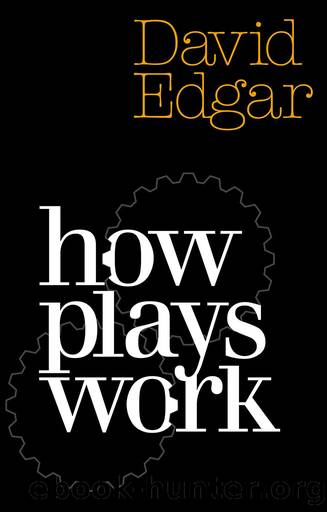How Plays Work (revised and updated edition) by David Edgar

Author:David Edgar [Edgar, David]
Language: eng
Format: epub
ISBN: 9781788504799
Publisher: Nick Hern Books
Published: 0101-01-01T00:00:00+00:00
Later, Horton apologises to her collaborators (for, among other things, not replying to emails). In one sense, you could not get more authored than a show written by and about its performer. But many solo-show makers come out of the devising tradition, in which the process is collaborative from the start (as opposed to the playwright writing a script, which is brought complete â if not finished â into the rehearsal room). Drama exercises typically used in devising processes often determine the forms and devices used in solo shows (leading, for example, to a greater emphasis on juxtaposition and thematic connections, rather than linear narrative, as a conveyor of meaning).
Often dominated by direct address to acknowledged spectators, solo shows also contribute to a growing challenge to the traditional, passive role of the theatre audience. This is nothing new: when I began in theatre in the early 1970s, extensive audience participation was a fruitfully unintended consequence of the 1968 abolition of theatre censorship (under which improvisation was forbidden). Planted actors in the audience â a device which goes back, at least, to Clifford Odetsâ 1935 play Waiting for Lefty â appeared in John Osborneâs 1972 A Sense of Detachment and elsewhere. The Traverse Theatre Workshop Companyâs U2 was a promenade show for a single audience member (who didnât know that when they booked). In Joint Stockâs 1974 The Speakers (written by Heathcote Williams and directed by William Gaskill and Max Stafford-Clark), the audience chose which character should deliver their Speakersâ Corner-style speech next (and heckled them as they did so). Often, participation was involuntary and it was sometimes physically or even sexually threatening; the Living Theatreâs 1969 season at the Roundhouse involved an invitation to the audience to strip off and join in. My own work at the time included a play about the Campaign for Nuclear Disarmament (The End) in which the outcome was decided nightly by an audience survey processed by a computer (occupying, at the time, an entire room).
Audience participation of this nature was largely a matter of manipulating theatrical convention in order to create meaning (the prevailing attitude to playgoers being summed up by the title of the leading German avant-garde play of the period, Peter Handkeâs Offending the Audience). The fact that, in my CND play, the evening could end with a peaceful resolution or Armageddon on the say-so of a machine was making a point about the risks of nuclear escalation, not about the relative importance of different elements in the theatre-making process. Now, many playwrights are inviting audience participation in order to democratise the process of performance.
So, David Greigâs 2011 show Fragile is a duologue about government cuts in which the part of one of the two characters is read by an audience member. In Duncan Macmillanâs Every Brilliant Thing, the single performer invites the audience to play, and indeed improvise, various characters in the story. But the most extensive recent use of audience participation as a metatheatrical device is in Tim Crouchâs 2019
Download
This site does not store any files on its server. We only index and link to content provided by other sites. Please contact the content providers to delete copyright contents if any and email us, we'll remove relevant links or contents immediately.
Kathy Andrews Collection by Kathy Andrews(11755)
The remains of the day by Kazuo Ishiguro(8883)
Spare by Prince Harry The Duke of Sussex(5130)
Paper Towns by Green John(5122)
Industrial Automation from Scratch: A hands-on guide to using sensors, actuators, PLCs, HMIs, and SCADA to automate industrial processes by Olushola Akande(5021)
The Body: A Guide for Occupants by Bill Bryson(5019)
Machine Learning at Scale with H2O by Gregory Keys | David Whiting(4255)
Be in a Treehouse by Pete Nelson(3994)
Never by Ken Follett(3868)
Harry Potter and the Goblet Of Fire by J.K. Rowling(3798)
Goodbye Paradise(3757)
Into Thin Air by Jon Krakauer(3340)
The Remains of the Day by Kazuo Ishiguro(3335)
Fairy Tale by Stephen King(3300)
The Cellar by Natasha Preston(3290)
The Genius of Japanese Carpentry by Azby Brown(3245)
120 Days of Sodom by Marquis de Sade(3219)
The Man Who Died Twice by Richard Osman(3035)
Drawing Shortcuts: Developing Quick Drawing Skills Using Today's Technology by Leggitt Jim(3033)
